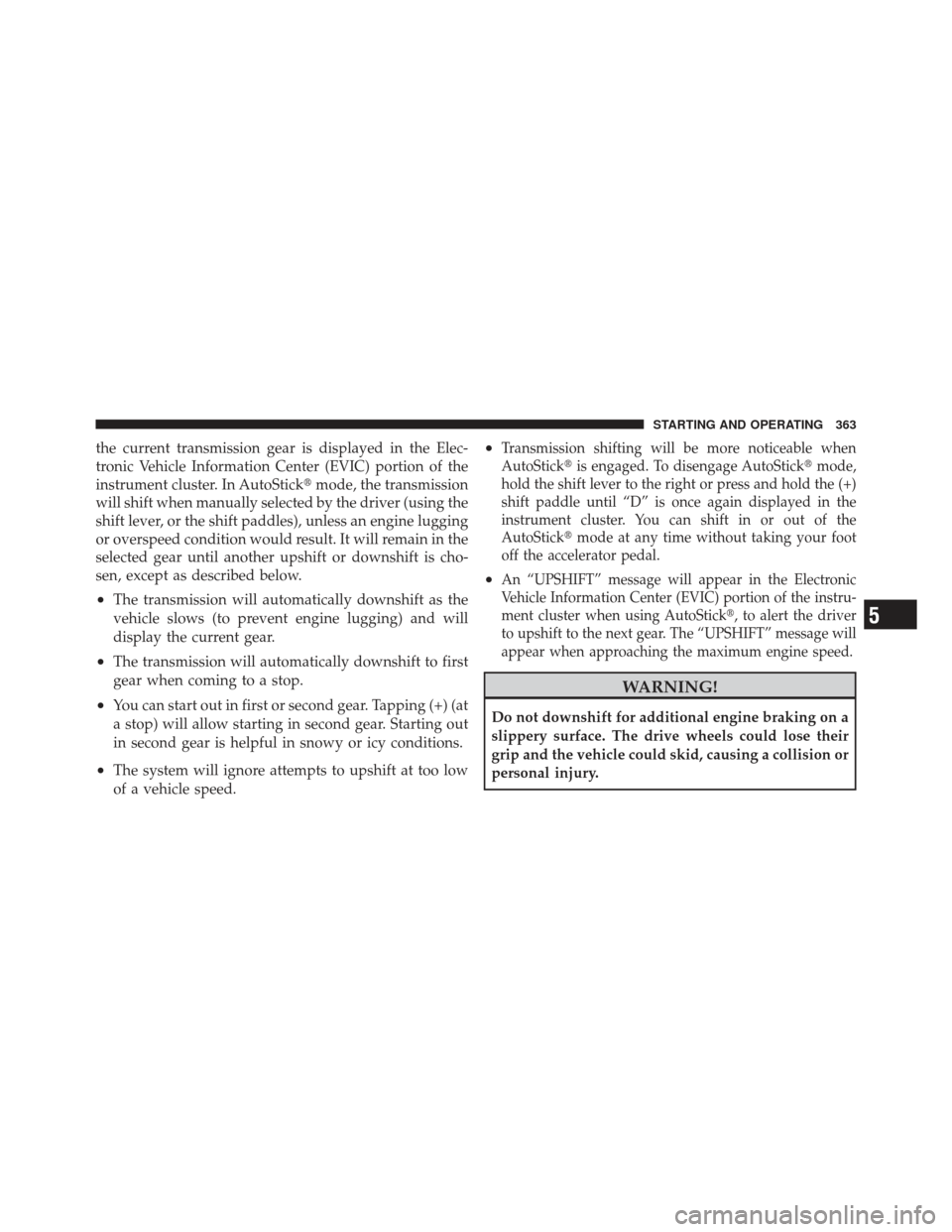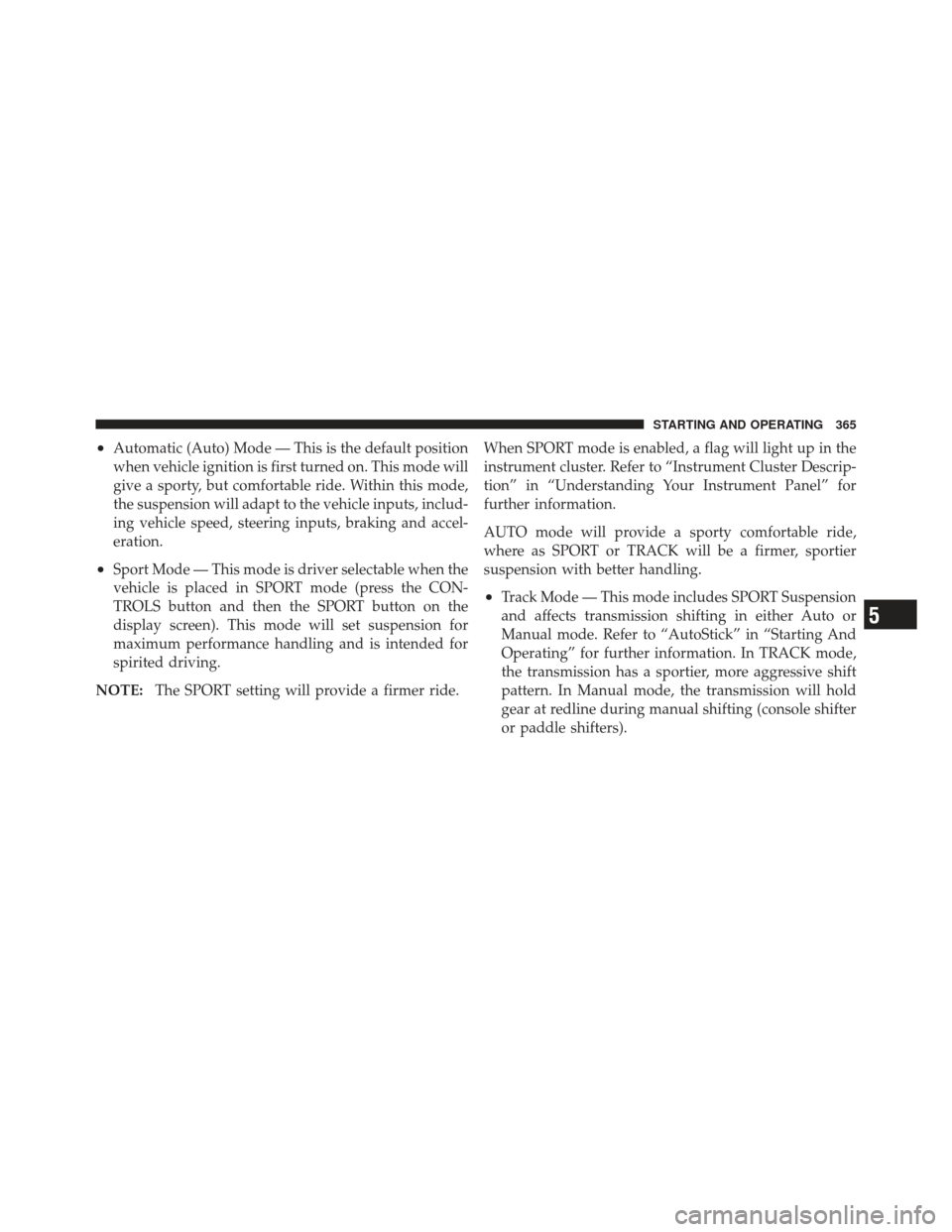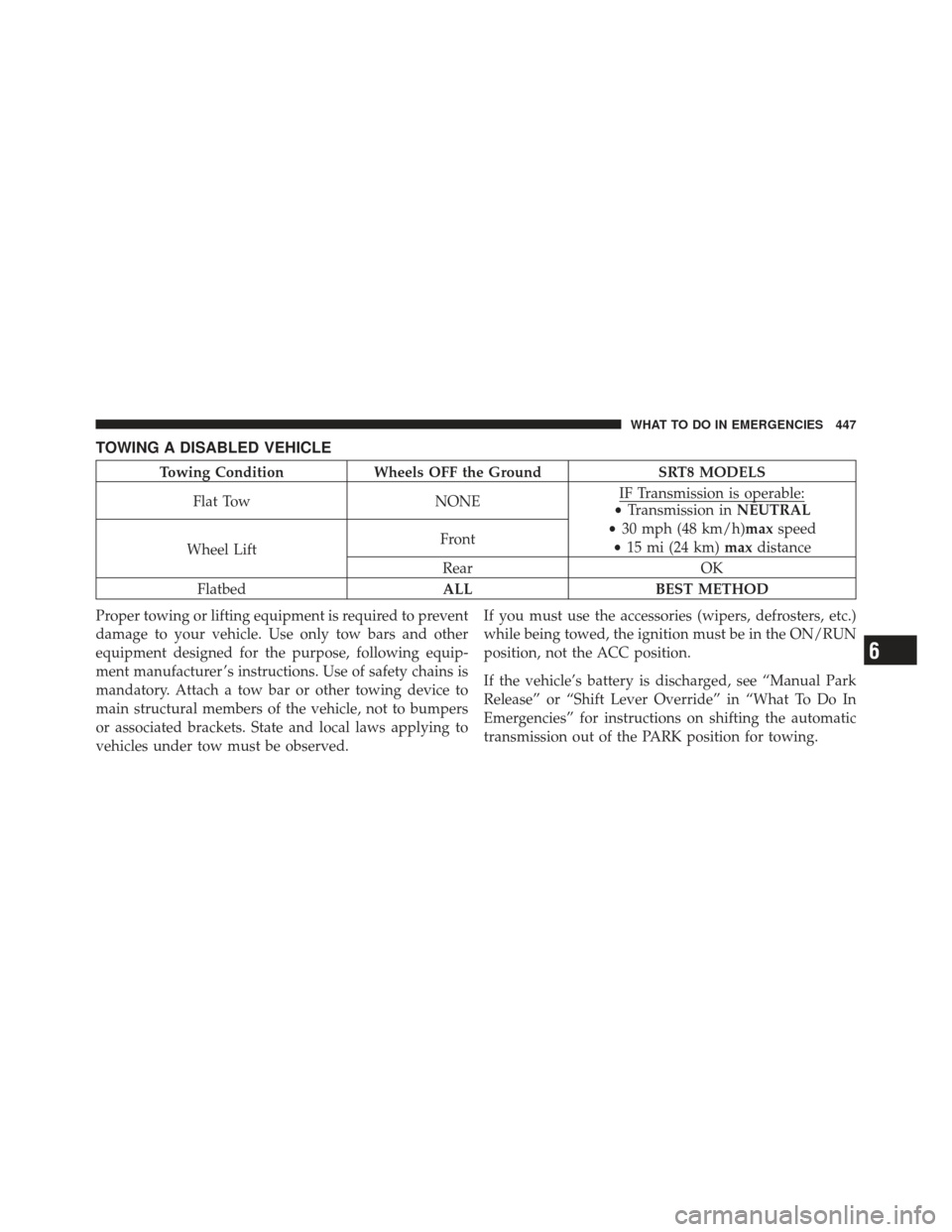Page 365 of 557

the current transmission gear is displayed in the Elec-
tronic Vehicle Information Center (EVIC) portion of the
instrument cluster. In AutoStick�mode, the transmission
will shift when manually selected by the driver (using the
shift lever, or the shift paddles), unless an engine lugging
or overspeed condition would result. It will remain in the
selected gear until another upshift or downshift is cho-
sen, except as described below.
•The transmission will automatically downshift as the
vehicle slows (to prevent engine lugging) and will
display the current gear.
•The transmission will automatically downshift to first
gear when coming to a stop.
•You can start out in first or second gear. Tapping (+) (at
a stop) will allow starting in second gear. Starting out
in second gear is helpful in snowy or icy conditions.
•The system will ignore attempts to upshift at too low
of a vehicle speed.
•Transmission shifting will be more noticeable when
AutoStick� is engaged. To disengage AutoStick �mode,
hold the shift lever to the right or press and hold the (+)
shift paddle until “D” is once again displayed in the
instrument cluster. You can shift in or out of the
AutoStick� mode at any time without taking your foot
off the accelerator pedal.
•An “UPSHIFT” message will appear in the Electronic
Vehicle Information Center (EVIC) portion of the instru-
ment cluster when using AutoStick�, to alert the driver
to upshift to the next gear. The “UPSHIFT” message will
appear when approaching the maximum engine speed.
WARNING!
Do not downshift for additional engine braking on a
slippery surface. The drive wheels could lose their
grip and the vehicle could skid, causing a collision or
personal injury.
5
STARTING AND OPERATING 363
Page 366 of 557
Auto
•
If AutoStick�is engaged while in “Auto” mode, the
transmission will automatically shift up if maximum
engine speed is reached.
•Heavily pressing the accelerator pedal may generate
an automatic downshift for improved acceleration.
•This mode should be used for most driving situations.
Sport
•
If AutoStick is engaged while in “Sport” mode, the
transmission will remain in the selected gear even
when maximum engine speed is reached.
•Engine overspeed protection is achieved through fuel
cut off at or near redline.
•This mode will provide aggressive shifting and is
intended for spirited driving.
SPORT MODE
This vehicle is equipped with an electronic controlled
dampening system. This system reduces body roll and
pitch in many driving situations including cornering,
acceleration and braking. There are three modes of op-
eration:
SPORT Mode
364 STARTING AND OPERATING
Page 367 of 557

•Automatic (Auto) Mode — This is the default position
when vehicle ignition is first turned on. This mode will
give a sporty, but comfortable ride. Within this mode,
the suspension will adapt to the vehicle inputs, includ-
ing vehicle speed, steering inputs, braking and accel-
eration.
•Sport Mode — This mode is driver selectable when the
vehicle is placed in SPORT mode (press the CON-
TROLS button and then the SPORT button on the
display screen). This mode will set suspension for
maximum performance handling and is intended for
spirited driving.
NOTE: The SPORT setting will provide a firmer ride. When SPORT mode is enabled, a flag will light up in the
instrument cluster. Refer to “Instrument Cluster Descrip-
tion” in “Understanding Your Instrument Panel” for
further information.
AUTO mode will provide a sporty comfortable ride,
where as SPORT or TRACK will be a firmer, sportier
suspension with better handling.
•Track Mode — This mode includes SPORT Suspension
and affects transmission shifting in either Auto or
Manual mode. Refer to “AutoStick” in “Starting And
Operating” for further information. In TRACK mode,
the transmission has a sportier, more aggressive shift
pattern. In Manual mode, the transmission will hold
gear at redline during manual shifting (console shifter
or paddle shifters).
5
STARTING AND OPERATING 365
Page 444 of 557
1. Set the parking brake, shift the automatic transmission
into PARK and turn the ignition to LOCK.
2. Turn off the heater, radio, and all unnecessary electri-
cal accessories.
3. If using another vehicle to jump-start the battery, park
the vehicle within the jumper cables reach, set the
parking brake and make sure the ignition is OFF.
WARNING!
Do not allow vehicles to touch each other as this
could establish a ground connection and personal
injury could result.
Jump-Starting Procedure
WARNING!
Failure to follow this procedure could result in per-
sonal injury or property damage due to battery ex-
plosion.
CAUTION!
Failure to follow these procedures could result in
damage to the charging system of the booster vehicle
or the discharged vehicle.
442 WHAT TO DO IN EMERGENCIES
Page 449 of 557

TOWING A DISABLED VEHICLE
Towing ConditionWheels OFF the Ground SRT8 MODELS
Flat Tow NONEIF Transmission is operable:
•
Transmission in NEUTRAL
• 30 mph (48 km/h)max speed
• 15 mi (24 km) maxdistance
Wheel Lift Front
Rear OK
Flatbed ALLBEST METHOD
Proper towing or lifting equipment is required to prevent
damage to your vehicle. Use only tow bars and other
equipment designed for the purpose, following equip-
ment manufacturer ’s instructions. Use of safety chains is
mandatory. Attach a tow bar or other towing device to
main structural members of the vehicle, not to bumpers
or associated brackets. State and local laws applying to
vehicles under tow must be observed. If you must use the accessories (wipers, defrosters, etc.)
while being towed, the ignition must be in the ON/RUN
position, not the ACC position.
If the vehicle’s battery is discharged, see “Manual Park
Release” or “Shift Lever Override” in “What To Do In
Emergencies” for instructions on shifting the automatic
transmission out of the PARK position for towing.
6
WHAT TO DO IN EMERGENCIES 447
Page 454 of 557
▫Brake System ....................... 476
▫ Automatic Transmission ............... 479
▫ Rear Axle .......................... 481
▫ Appearance Care And Protection From
Corrosion .......................... 481
� Fuses .............................. 487
▫ Integrated Power Module .............. 487
▫ Rear Power Distribution Center .......... 491
� Vehicle Storage ....................... 495
� Replacement Bulbs .................... 496 �
Bulb Replacement ..................... 497
▫ Low Beam Headlamp, High Beam
Headlamp, Park/Turn Lamp, Inner Park
Lamp, And Outer Park Lamp ............ 497
▫ Rear Backup Lamp And Turn Signal
Lamps ............................ 500
▫ License Lamp ....................... 501
� Fluid Capacities ...................... 502
� Fluids, Lubricants, And Genuine Parts ....... 503
▫ Engine ............................ 503
▫ Chassis ........................... 504
452 MAINTAINING YOUR VEHICLE
Page 456 of 557

ONBOARD DIAGNOSTIC SYSTEM — OBD II
Your vehicle is equipped with a sophisticated onboard
diagnostic system called OBD II. This system monitors
the performance of the emissions, engine, and automatic
transmission control systems. When these systems are
operating properly, your vehicle will provide excellent
performance and fuel economy, as well as engine emis-
sions well within current government regulations.
If any of these systems require service, the OBD II system
will turn on the “Malfunction Indicator Light (MIL).” It
will also store diagnostic codes and other information to
assist your service technician in making repairs. Al-
though your vehicle will usually be drivable and not
need towing, see your authorized dealer for service as
soon as possible.CAUTION!
•Prolonged driving with the MIL on could cause
further damage to the emissions control system. It
could also affect fuel economy and driveability.
The vehicle must be serviced before any emissions
tests can be performed.
•If the MIL is flashing while the engine is running,
severe catalytic converter damage and power loss
will soon occur. Immediate service is required.
EMISSIONS INSPECTION AND MAINTENANCE
PROGRAMS
In some localities, it may be a legal requirement to pass
an inspection of your vehicle’s emissions control system.
Failure to pass could prevent vehicle registration.
454 MAINTAINING YOUR VEHICLE
Page 481 of 557

Automatic Transmission
Selection Of Lubricant
It is important that the proper lubricant is used in the
transmission to assure optimum transmission perfor-
mance. Use only manufacturer ’s recommended transmis-
sion fluid. Refer to “Fluids, Lubricants, and Genuine
Parts” in “Maintaining Your Vehicle” for further informa-
tion. It is important that the transmission fluid be main-
tained at the prescribed level using the recommended
fluid. No chemical flushes should be used in any trans-
mission; only the approved lubricant may be used.
Special Additives
Automatic Transmission Fluid (ATF) is an engineered
product and its performance may be impaired by supple-
mental additives. Therefore, do not add any fluid addi-
tives to the transmission. The only exception to this
policy is the use of special dyes to aid in detecting fluid
leaks. In addition, avoid using transmission sealers as
they may adversely affect seals.
CAUTION!
Do not use chemical flushes in your transmission as
the chemicals can damage your transmission compo-
nents. Such damage is not covered by the New
Vehicle Limited Warranty.
7
MAINTAINING YOUR VEHICLE 479